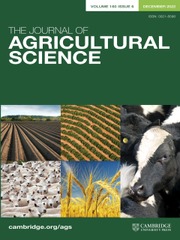Article contents
Use of a long-term rumen simulation technique (Rusitec) to provide micro-organisms for in vitro digestibility assays
Published online by Cambridge University Press: 27 March 2009
Summary
Four experiments involving the two-stage in vitro digestibility technique of Tilley & Terry (1963) were undertaken to investigate whether cow rumen liquor could be replaced with effluent or extract from feed residue containing micro-organisms derived from the long-term rumen simulation technique (Rusitec) of Czerkawski & Breckenridge (1977).
In Expts 1 and 2, the dry matter digestibility (DMD) of hay was determined using either cow rumen liquor or Rusitec liquid effluent or extract from feed after 48 h of digestion in a Rusitec apparatus using various volumes of liquor and artificial saliva. Digestibilities determined with rumen liquor were c. 70% (c.v. 1·2%) while those determined with Rusitec effluent or extract were c. 62% (c.v. 1·8%). In treatments common to Expts 1 and 2, Rusitec effluent digestibilities were more repeatable than extract or rumen liquor digestibilities.
In Expts 3 and 4, Rusitec effluent was compared with cow rumen liquor for determining DMD of seven forages with DMD ranging from 33 to 70%. For a given feed there was good agreement between experiments in DMD values determined with Rusitec effluent, and for ten paired values there was a high correlation (r2 = 0·976) between DMD determined by the two methods. DMD determined using rumen liquor (y) was accurately predicted by Rusitec liquid effluent digestibility (x) from the equation y = 2·663 + 1·06477.x; R.S.D. 2·433.
The results show that Rusitec liquid effluent can be used instead of rumen liquor as a source of micro-organisms for the two-stage in vitro digestibility method. Routine use of Rusitec would obviate the need for using fistulated animals.
Information
- Type
- Animals
- Information
- Copyright
- Copyright © Cambridge University Press 1991
References
REFERENCES
- 4
- Cited by

